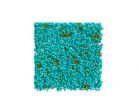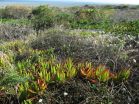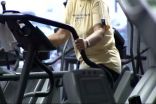(Press-News.org) When asked to describe a forest or a meadow, most people would probably begin with the plants, the species diversity, or the color of the foliage. They probably wouldn't pay much attention to the animals living in the soil.
But a new Yale-led study shows the critical importance of earthworms, beetles, and other tiny creatures to the structure of grasslands and the valuable ecosystem services they provide.
During a 3-year study, researchers found that removing these small animals from the soil of a replicated Scottish sheep meadow altered the plant species that grew in the ecosystem, reduced overall productivity, and produced plants that were less responsive to common agricultural management, such as fertilization.
The results reflect the long-term ecological impacts of land use changes, such as the conversion of forests to agricultural land, researchers say.
"We know these soil animals are important controls on processes which cause nutrients and carbon to cycle in ecosystems, but there was little evidence that human-induced loss of these animals has effects at the level of the whole ecosystem, on services such as agricultural yield," said Mark Bradford, an Associate Professor at the Yale School of Forestry & Environmental Studies (F&ES) and lead author of the study published in the Proceedings of the National Academy of Sciences.
"Yet that's exactly what we found."
At a climate-controlled laboratory, the researchers assembled 16 bathtub-sized replicas of a Scottish upland grassland. Each of the models included the 10 most common plant species, but the researchers introduced earthworms, slugs, and other small creatures to only some of the systems.
During the first six months, the researchers found that removing the animals did not affect plant yield or the rate of carbon dioxide loss from the system. "But when we ran it out through 500 days we did actually find huge changes in the ecosystem processes, including productivity of the plants," Bradford says.
Interestingly, they also found that whereas grass yields were reduced, the quality of the yields was improved. (Quality is measured by the concentration of proteins in the plants.)
Bradford says the experiment differed from earlier research in two important ways: They were able to replicate much of the complexity of the real world by using many species of plants and soil organisms, and they were able to simulate multiple years of summer growing conditions.
The study was a collaboration between researchers from Yale and Columbia University, as well as collaborators in the United Kingdom, Germany, and Switzerland.
"These findings emphasize how interconnected the belowground and aboveground components of ecosystems are and that different ecosystem processes respond in different ways to the management of grasslands," said Stephen Wood '11 M.E.Sc. a doctoral student at Columbia University and and co-author of the study.
"In this case, the loss of soil animal diversity eventually changed the dominant plant species in the meadow ecosystems, and then in turn the productivity of these grasslands and how they responded to agricultural management," Bradford said. "When you next look out at a meadow or forest, remember that the tiny animals immediately beneath your feet are likely responsible for much of what you see."
INFORMATION:
LOS ANGELES – (Oct. 2, 2014) – Surveying patients with traumatic brain injuries, a group of Los Angeles Biomedical Research Institute (LA BioMed) researchers reported today that they found those who tested positive for THC, the active ingredient in marijuana, were more likely to survive than those who tested negative for the illicit substance.
The findings, published in the October edition of The American Surgeon, suggest THC, or tetrahydrocannabinol, may help protect the brain in cases of traumatic brain injury, the researchers said. The study included 446 patients who ...
New Rochelle, NY, October 2, 2014–Women who have a history of violent sexual abuse may suffer emotional distress during a routine pelvic examination. Healthcare providers would benefit from greater awareness of symptoms predictive of examination-related distress in this patient population, according to a study published in Violence and Gender, a new peer-reviewed journal from Mary Ann Liebert, Inc., publishers. The article is available free on the Violence and Gender website at http://online.liebertpub.com/doi/full/10.1089/vio.2014.0016 until November 2, 2014.
In the ...
VIDEO:
Researchers from the University of Pennsylvania and the University of California, Santa Barbara, have now shown how giant clams use iridescent structures to thrive, operating as exceedingly efficient, living greenhouses...
Click here for more information.
Evolution in extreme environments has produced life forms with amazing abilities and traits. Beneath the waves, many creatures sport iridescent structures that rival what materials scientists can make in the laboratory.
A ...
PHILADELPHIA, PA – Physicians have long speculated at the hard-to-treat nature of joint infection. In an article published in Journal of Infectious Diseases, Thomas Jefferson University scientists, in collaboration with scientists at the National Institutes of Health, come one step closer to understanding why these infections are so tough to tackle. The results could help explain the joint pain caused by different infections, including Lyme disease and why they're so resistant to antibiotic treatment.
"Biofilm formation has been suspected to play a key role during septic ...
New research suggests treatment in Australia and New Zealand for patients with sepsis is the best in the world.
The large-scale six-year study, led by the Australian and New Zealand Intensive Care Research Centre at Monash University, divided 1600 patients into two groups, who were admitted to emergency care with early stage sepsis from across more than 40 hospitals.
The first group of 796 patients received Early Goal Directed Therapy (EGDT), an aggressive treatment not currently used in Australia and New Zealand, which inserts a catheter into the jugular vein to monitor ...
Published today in PLOS ONE, the study is the first in the world to show that it is possible to predict abstract judgments from brain waves, even though people were not conscious of making such judgments.
The study also increases our understanding of impulsive behaviours and how to regulate it.
It found that researchers could predict from participants' brain activity how exciting they found a particular image to be, and whether a particular image made them think more about the future or the present.
This is true even though the brain activity was recorded before ...
PROVIDENCE, R.I. [Brown University] — Dov Sax of Brown University and Jason Fridley of Syracuse University aren't proposing a novel idea to explain species invasiveness. In fact, Charles Darwin articulated it first. What's new about Sax and Fridley's "Evolutionary Imbalance Hypothesis" (EIH) is that they've tested it using quantifiable evidence and report in Global Ecology and Biogeography that the EIH works well.
The EIH idea is this: Species from regions with deep and diverse evolutionary histories are more likely to become successful invaders in regions with less deep, ...
Molecular studies of plants often depend on high-quantity and high-quality DNA extractions. This can be quite difficult in plants, however, due to a diversity of compounds and physical properties found in plants. "Tannins, tough fibrous material, and/or secondary compounds can interfere with DNA isolation," explains Dr. Thomas Givnish, principal investigator of a new study published by Jackson Moeller et al. in the October issue of Applications in Plant Sciences (available for free viewing at http://www.bioone.org/doi/pdf/10.3732/apps.1400048).
This is further complicated ...
WASHINGTON, Oct. 2, 2014—Commercial devices capable of encrypting information in unbreakable codes exist today, thanks to recent quantum optics advances, especially the generation of photon pairs—tiny entangled particles of light. Now, an international team of researchers led by professor Roberto Morandotti of INRS-EMT in Canada, is introducing a new method to achieve a different type of photon pair source that fits into the tiny space of a computer chip.
The team's method, which generates "mixed up" photon pairs from devices that are less than one square millimeter ...
VIDEO:
A new study suggests ibuprofen can make old lungs look young. In lab tests, daily ibuprofen lowered lung inflammation in elderly mice. The research and its implications are described by...
Click here for more information.
COLUMBUS, Ohio – New research shows that the lungs become more inflammatory with age and that ibuprofen can lower that inflammation.
In fact, immune cells from old mouse lungs fought tuberculosis bacteria as effectively as cells from young mice after ...




